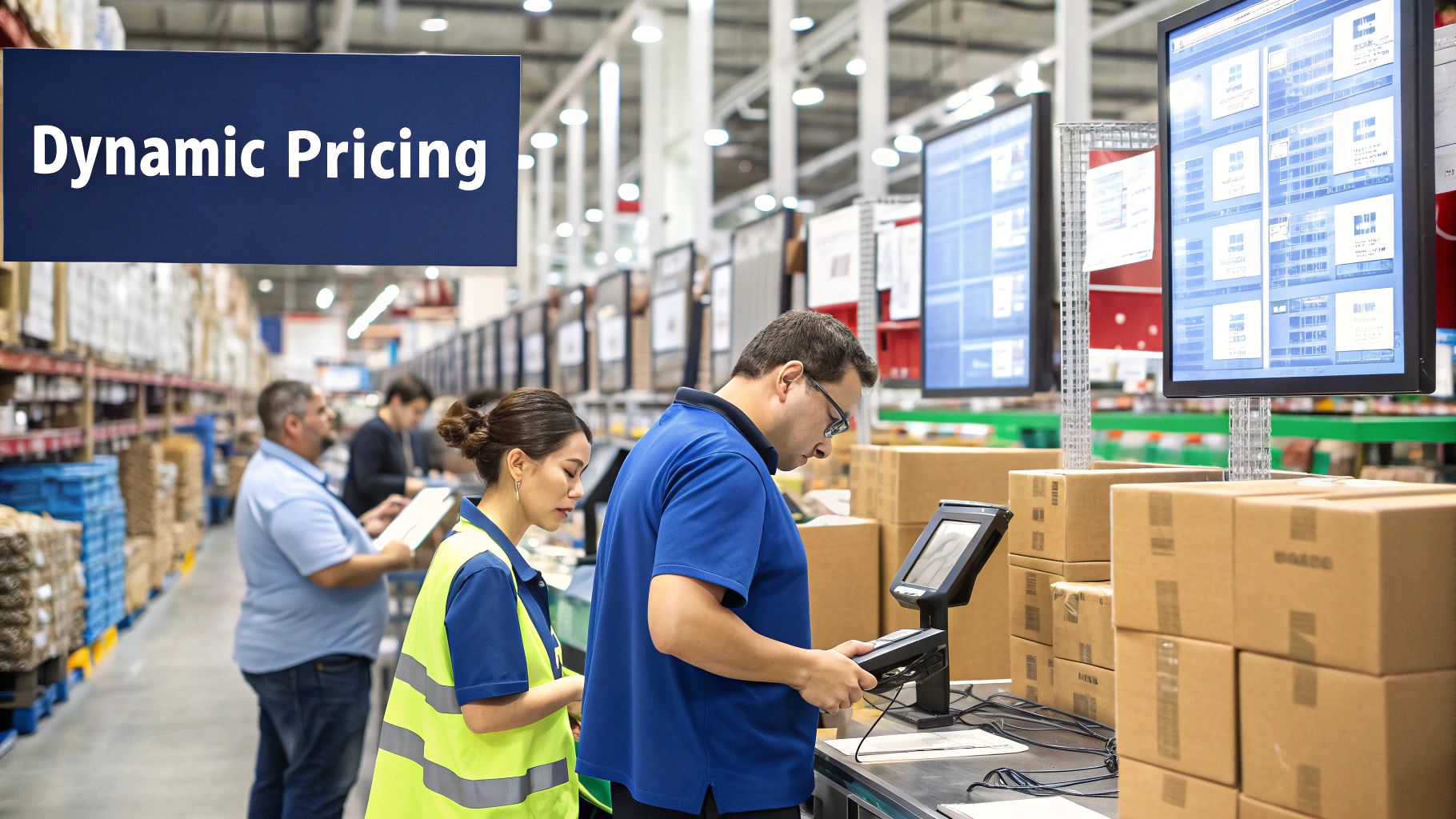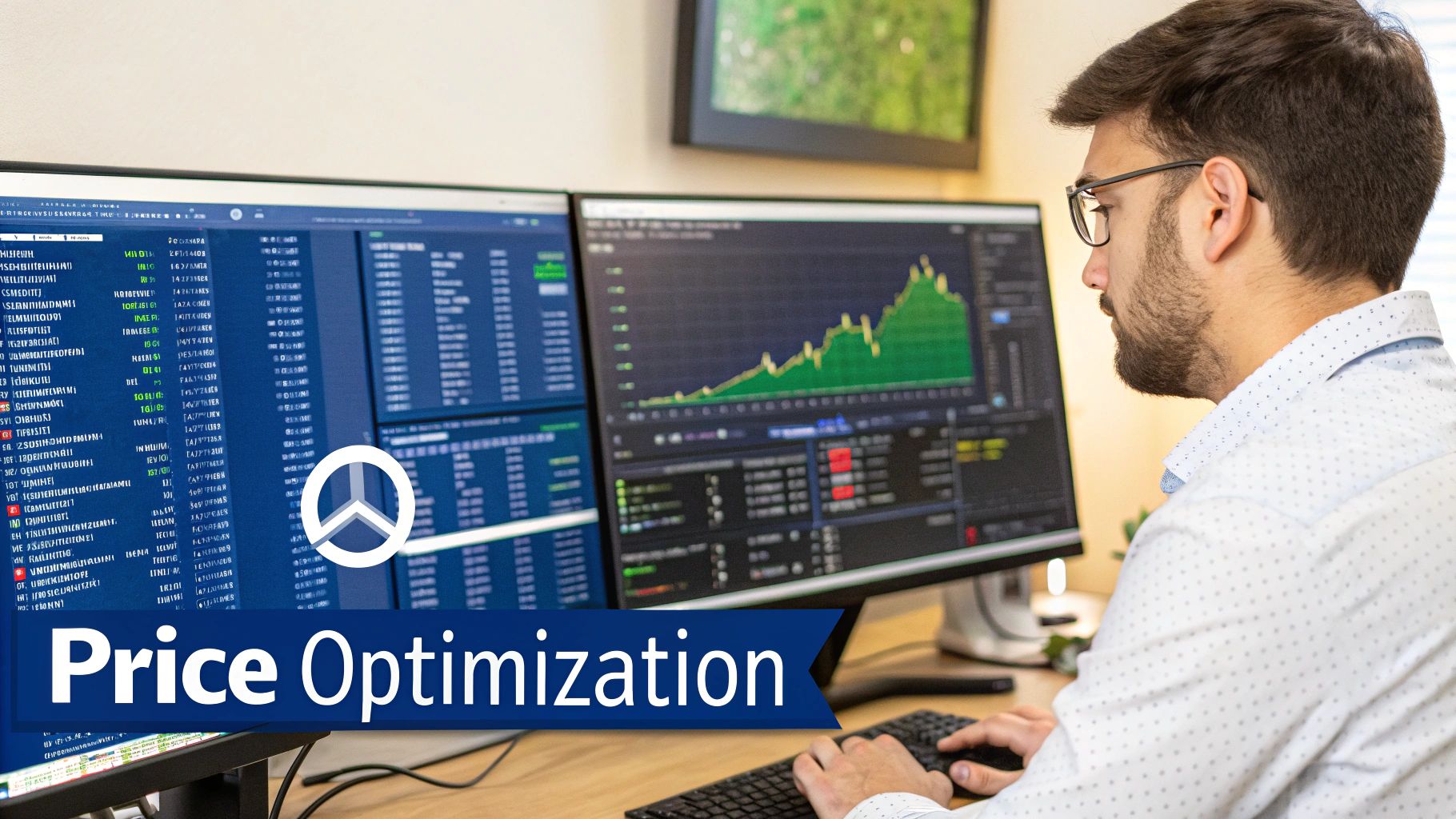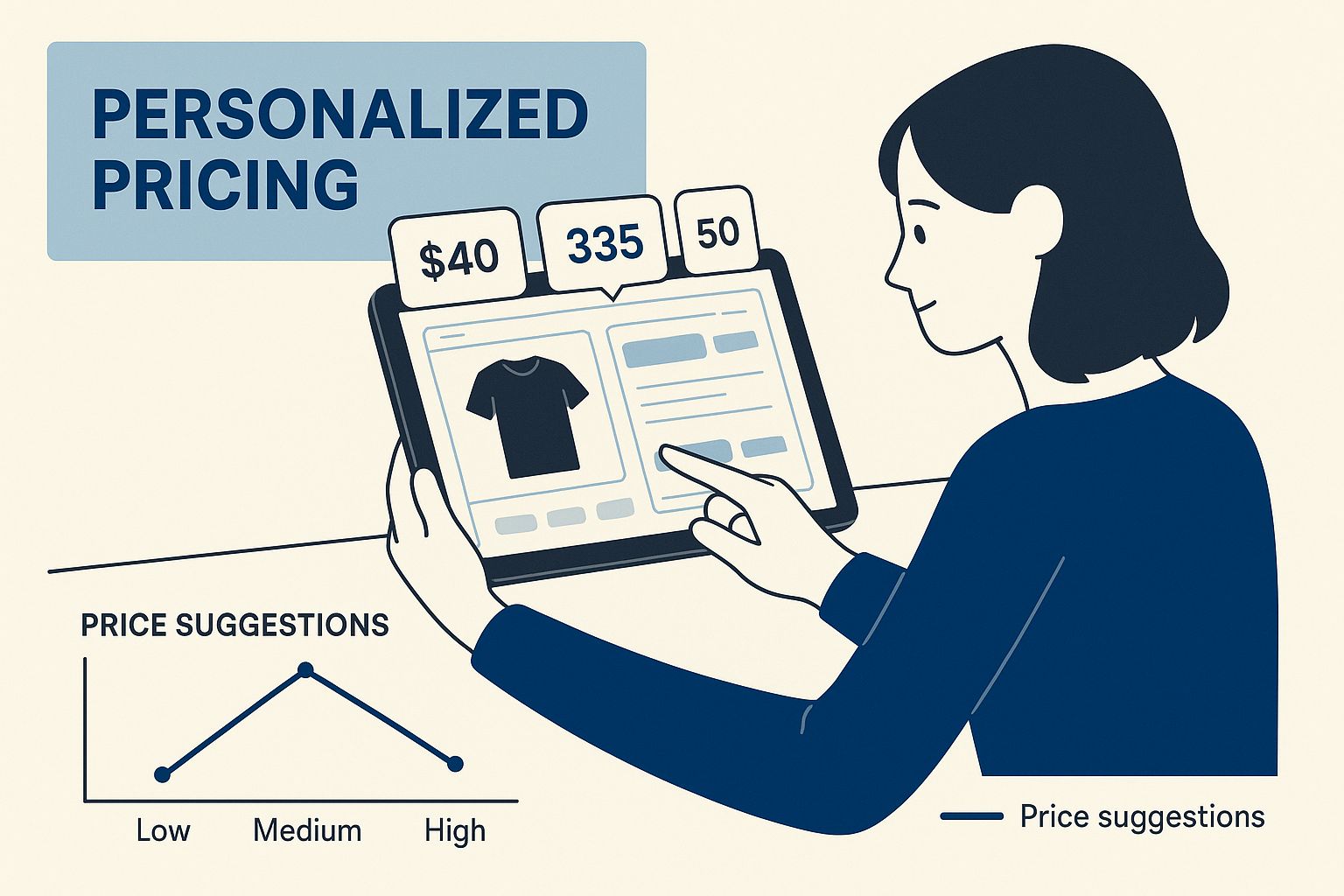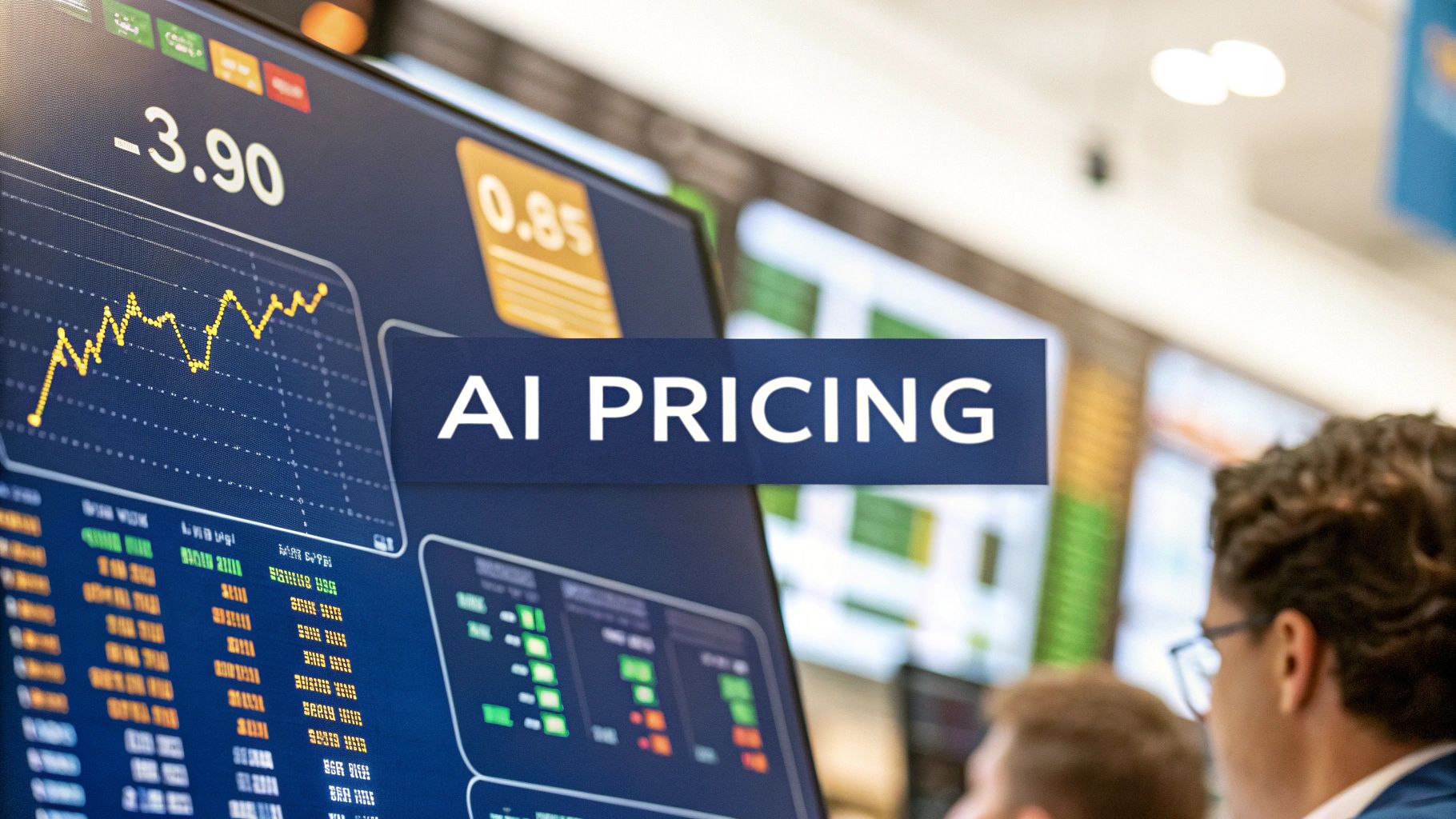When you hear about AI in ecommerce pricing, don't think of some far-off, complicated technology. At its heart, it’s about using smart algorithms to automatically adjust your product prices based on what’s happening in the market right now. Instead of those old "set-it-and-forget-it" price tags, AI creates what we call dynamic pricing. This means your prices can instantly respond to competitor moves, shifts in customer demand, and even your own inventory levels, making sure you’re always hitting that sweet spot.
The End of Static Pricing

In the hyper-competitive world of online retail, setting a price and just hoping for the best is a fast track to getting left behind. Sticking with a static price is like trying to sail a ship with a locked rudder; you simply can't react when the winds or currents change. This old-school approach almost guarantees you're leaving money on the table or losing out to more nimble competitors.
This is exactly where AI-driven pricing comes into play. It’s less like a cold algorithm and more like a strategic partner dedicated to your growth. Imagine having an expert pricing analyst for every single product in your catalogue, working 24/7 to find the perfect price. That's what AI does, sifting through countless data points at once to make sharp, profitable decisions.
What AI Analyzes in Real Time
AI doesn't just pull numbers out of thin air; it makes calculated moves. Its real power lies in its ability to process a massive amount of information in the blink of an eye. Of course, before you let an AI take the wheel, having a solid grasp of fundamental ecommerce pricing strategies is essential. That knowledge provides the foundation for what the AI will ultimately automate and perfect.
Here are the key data points an AI system constantly juggles:
-
Competitor Prices: The system is always watching what your rivals are charging. It adjusts your prices to keep you competitive without needlessly sacrificing your margins.
-
Customer Behaviour: It looks at browsing history, cart abandonment rates, and past purchases to get a feel for what different customer groups are willing to pay.
-
Market Demand: Is a product suddenly trending? The AI can nudge prices up to capitalize on the hype. During a slow period, it can do the opposite to drum up sales.
-
Inventory Levels: If you’re overstocked on a particular item, the AI can apply a small discount to help clear the shelves. If a product is nearly sold out, it might raise the price to maximize profit on the last few units.
By continuously learning from this data, AI pricing models become smarter over time. They don't just react to the market; they begin to predict it, giving you a significant advantage.
Making the switch from manual guesswork to automated intelligence is all about driving real business results. This isn't just about changing numbers on a webpage; it’s a systematic way to improve your bottom line. The benefits are clear: you can boost revenue, protect your profit margins, and even improve customer satisfaction by offering fair, market-driven prices. This guide will walk you through exactly how to implement a winning AI in an ecommerce pricing strategy.
How AI Pricing Algorithms Actually Work

Trying to figure out how AI in ecommerce pricing actually functions can feel a bit like peeking into a black box. But once you pull back the curtain, it’s less about sorcery and more about smart, systematic logic. These algorithms are essentially sets of rules that learn and adapt, processing information just like a person would, only at a speed and scale that’s impossible for any human team.
Think of an AI pricing tool like a Waze or Google Maps for your products. A navigation app doesn’t just give you a single route; it’s constantly analyzing traffic jams, road closures, and speed limits to pinpoint the absolute fastest way to get there. AI pricing algorithms do the same for your profits, continuously recalculating the optimal price based on an ever-changing market.
Let’s break down the main ways these systems approach the problem.
The Market Scout Approach
One of the most common methods is rooted in competitive pricing. Imagine this type of algorithm as your personal market scout: one that never sleeps. It’s on the job 24/7, keeping a close eye on what your direct competitors are up to, tracking every price adjustment, new promotion, and stock level change they make.
To do this, the AI needs a constant stream of information, which is often gathered using tools like specialized Amazon product scrapers to see what the competition is doing. This data becomes the fuel for the AI to follow the rules you’ve set.
For instance, you could program a rule like: "Always price this product 5% lower than Competitor X, but never let the profit margin dip below 30%." The AI takes it from there, automating the strategy without fail. The second Competitor X tweaks their price, yours adjusts almost instantly. This keeps you competitive without getting dragged into a race to the bottom that erodes your margins.
The Customer Psychologist Model
A more sophisticated approach is value-based pricing. This model acts less like a scout and more like a customer psychologist. Instead of just looking sideways at competitors, it digs deep into what a product is actually worth to different shoppers at different times. It’s all about analyzing customer behaviour to get a read on demand and willingness to pay.
This model weighs several key factors:
-
Customer Segments: Are first-time visitors less sensitive to price than loyal, returning customers? The AI can spot these patterns and suggest unique prices or promotions for each group.
-
Time and Seasonality: A parka has a much higher perceived value in November than it does in May. This algorithm gets that context and adjusts prices to match the season.
-
Perceived Scarcity: When stock levels for a popular item drop to just a handful of units, the AI knows its value in the customer's mind has just shot up. It can then nudge the price higher to maximize profit on those last few sales.
By focusing squarely on the customer, value-based models help you capture the most revenue possible from every single transaction. The core question shifts from "What are other stores charging?" to "What is the true value we're delivering?"
The Predictive Forecaster Engine
The most advanced AI pricing tools use machine learning to predict what’s going to happen next. This is where that navigation app analogy really clicks. An app predicts your arrival time by analyzing both historical traffic data and what’s happening on the road right now. In the same way, a machine learning algorithm forecasts future demand and sales by looking at past performance and current market trends.
This model dives into your historical sales figures, website traffic, conversion rates, and even external data points like upcoming holidays or major industry news. It can identify complex patterns that a human analyst would almost certainly miss, allowing it to make incredibly accurate predictions about how a price change today will affect sales and revenue tomorrow.
And these systems are always learning. Every sale, every abandoned cart, every competitor price change is a new piece of data that refines its understanding of the market. This constant learning cycle is fundamental to using https://www.cleffex.com/blog/ecommerce-predictive-analytics-boost-sales/ and is what gives AI-powered pricing its edge. It lets your strategy evolve and get smarter every single day, keeping you a step ahead of the curve.
Here is the rewritten section, designed to sound completely human-written and natural.
Real-World Benefits of AI-Powered Pricing
It’s one thing to understand the theory behind AI pricing algorithms, but seeing what they can actually do for your business is where things get exciting. Adopting an AI-powered pricing strategy isn't just about putting tasks on autopilot; it’s about unlocking real, tangible benefits that old-school static pricing could never deliver.
We're talking about everything from healthier profit margins to stronger customer relationships. This isn’t just about keeping up with the competition, but proactively shaping your position in the market.
Maximize Profit Margins on Every Sale
Let's be honest, the main goal of any pricing strategy is to maximize profit. This is where AI really shines. It's incredibly good at finding that perfect balance, the highest price a customer is willing to pay at any given moment, factoring in demand, competitor prices, and even perceived value.
Think of it this way: if a hot new pair of sneakers is low in stock and trending on social media, the AI can nudge the price up incrementally to capture every last dollar of that high demand. On the flip side, if you're overstocked on an item, the system can calculate the smallest possible discount needed to clear out inventory without completely gutting your margins. It's a surgical approach that ensures you’re never leaving money on the table.

This image shows just how that works, delivering personalized pricing suggestions directly to a shopper and moving well beyond the old one-size-fits-all model.
Increase Conversion Rates with Smart Discounts
Blanket sales and site-wide discounts are often a blunt instrument, cutting into profits where you don't need to. AI pricing tools allow for much smarter, timely promotions that push conversions right when and where they matter most.
For example, the system can spot a shopper who abandoned their cart and automatically send them a personalized, time-sensitive discount. It’s the perfect nudge to get them to complete the purchase.
This isn't just random discounting; it's precision marketing. By offering the right incentive to the right person at the right time, you turn hesitation into a sale while protecting your overall price integrity.
This kind of smart pricing is quickly becoming a cornerstone of modern retail in Canada. Ecommerce sales are projected to hit over $74 billion CAD in 2025, and a big driver of that growth is AI's ability to fine-tune pricing on the fly. In fact, many Canadian businesses expect AI to boost their profit margins by nearly 60% by 2035.
To see just how different the two approaches are, let's break it down.
Traditional Pricing vs AI-Driven Pricing
The shift from manual, "set-it-and-forget-it" pricing to a dynamic, AI-powered model is a massive leap forward. The table below lays out the key differences.
|
Feature |
Traditional Pricing |
AI-Driven Pricing |
|---|---|---|
|
Speed & Agility |
Manual adjustments; slow to react to market changes. |
Real-time, automated adjustments in seconds. |
|
Data Analysis |
Based on historical data and gut feelings. |
Processes thousands of data points (competitors, demand, etc.) |
|
Personalization |
One price for all customers. |
Can offer personalized prices or discounts based on user behaviour. |
|
Profit Optimization |
Often leaves money on the table or discounts too heavily. |
Continuously seeks the optimal price point to maximize margins. |
|
Strategy |
Reactive and often simplistic. |
Proactive, strategic, and aligned with long-term business goals. |
As you can see, AI doesn't just do the same job faster; it completely changes the game. It allows for a level of sophistication that was simply impossible before.
Gain Unmatched Market Agility
The ecommerce world moves fast. A competitor can launch a flash sale, or a product can go viral in an instant. Trying to keep up with manual price changes is a losing battle, but an AI system reacts in real time. This agility gives you a powerful competitive edge.
-
Respond to Competitors Instantly: If a rival drops their price, your system can decide whether to match it or hold firm based on your strategy, all without you lifting a finger.
-
Capitalize on Trends: The AI can spot a sudden spike in demand for an item and adjust the price upward to reflect its newfound popularity.
-
Adapt to External Factors: It can even factor in things like local weather forecasts or upcoming holidays to predict shifts in demand and set prices ahead of time.
This constant adaptation ensures your store is always priced optimally. While the technology behind it is complex, the goal is simple: to make your business smarter and more responsive. Gaining a deeper understanding of how these systems work is crucial, which is why we've put together a guide on how AI in ecommerce is transforming retail success. Ultimately, AI-powered pricing helps you stop reacting to the market and start leading it.
Putting AI Pricing Into Action
Moving from theory to practice with AI in ecommerce pricing can feel like a huge jump. It’s easy to assume you need a team of data scientists on standby, but the reality is much more straightforward these days. Modern AI pricing tools are built to be user-friendly, turning what seems like a complex technical challenge into a series of manageable, strategic steps.
This is your practical roadmap. We’ll break down how to figure out your goals, pick the right software, and get your shop ready for a much smarter pricing strategy. The absolute key is to start with a clear objective; that single decision will guide everything else you do.
Define Your Primary Business Goal
Before you even start window-shopping for software, you have to answer one simple question: what do you actually want your pricing to do? An AI is an incredibly powerful tool, but it needs a mission. Your main goal becomes its north star, shaping the logic and rules it follows.
Most pricing objectives boil down to one of three things:
-
Maximizing Profit: If your main focus is on the bottom line, the AI will be tuned to find the highest price the market will bear for each item without killing the sale. It's all about prioritizing margin over volume, making small, smart increases wherever demand is strong.
-
Gaining Market Share: For businesses in growth mode, the AI can switch to a more aggressive stance. It will zero in on competitive pricing, sometimes matching or even slightly undercutting rivals to win over more buyers. This strategy aims to boost sales volume, even if it means taking a temporary hit on margins.
-
Liquidating Inventory: Got old stock you need to move? The AI can be set to prioritize speed. It'll figure out the perfect discounts to clear products quickly, freeing up cash and warehouse space without giving away more profit than necessary.
Your choice here isn’t set in stone. Any decent AI system will let you toggle between these strategies or even assign different goals to different product lines as your business needs evolve.
Choose the Right AI Pricing Software
Once you know your goal, it's time to find the right partner to help you achieve it. The market for AI pricing software is getting crowded, and not all tools are built the same. You need to find a solution that lines up with your business size, budget, and technical comfort level.
When you're sizing up different options, keep these key factors in mind:
-
Integration Capabilities: How well does it play with your ecommerce platform, whether it's Shopify, Magento, or BigCommerce? A smooth, easy integration is non-negotiable. It’s what allows data to flow seamlessly between your store and the pricing engine.
-
Ease of Use: Look for a tool with a clean dashboard and reports you can actually understand. You should be able to set rules, check on performance, and make sense of the AI's choices without a computer science degree.
-
Customization and Control: The best platforms strike a balance between automation and human oversight. You need the ability to set price floors and ceilings, create your own custom rules, and step in to override the AI's suggestions when your gut tells you to.
A huge part of this is making sure the software can plug into your entire tech stack. The right platform will fit neatly into your existing operations, a key principle in successful AI-powered ecommerce development, making the whole transition feel a lot less disruptive.
Prepare for a Successful Launch
With your software picked out, it's time to get everything teed up for launch. This last phase is all about making sure the AI has what it needs to hit the ground running. A little prep work here makes a massive difference in getting accurate and profitable results from day one.
Just follow this simple checklist to get you through the final steps:
-
Clean Your Data: An AI’s decisions are only as good as the data you feed it. Make sure your product info, sales history, and cost data are accurate, complete, and consistently formatted. Garbage in, garbage out.
-
Initial Setup and Configuration: Work with your new software provider to connect the tool to your shop and configure the initial pricing rules based on the goal you set earlier. This is where you’ll establish your guardrails, like minimum and maximum prices.
-
Start with a Pilot Test: Don't go all-in by flipping the switch on your entire catalogue. Start small. Pick a specific product category to test the system, see how it performs, and fine-tune things before a wider rollout.
-
Monitor and Refine: Once you're live, keep a close eye on your key metrics, such as sales, revenue, and profit margins. Use the software's analytics to understand the why behind the AI's pricing changes and keep tweaking your strategy over time.
By following these structured steps, you can successfully bring AI in ecommerce pricing into your business, turning powerful technology into a real engine for growth.
Here’s a rewrite of the section, crafted to sound like an experienced human expert.
Common Roadblocks and Staying on the Right Side of Your Customers
Let’s be honest: bringing a powerful new tool like AI into your pricing strategy isn't a simple plug-and-play operation. It comes with its own set of challenges. While AI in ecommerce pricing can be a game-changer, you have to be ready for the practical hurdles and, more importantly, walk the fine line of fairness and transparency with your customers.
If you get this wrong, what looks like a smart business move can quickly turn into a PR disaster. The real goal here is to use AI responsibly, creating a win-win for your business and the people buying from you. It’s all about building a pricing strategy that boosts your bottom line and earns long-term trust.
Navigating the Practical Hurdles
Before your AI can start working its magic, you've got to get the fundamentals right. These are the operational headaches that pop up anytime a business gets serious about using data. Nail these, and your AI has a fighting chance.
Three issues tend to surface right away:
-
Data Quality and Quantity: Your AI pricing engine is only as good as the data you feed it. If your sales history is a mess, full of gaps, errors, or inconsistencies, the AI's suggestions will be garbage. You need a clean, solid foundation of data on everything from past sales and customer behaviour to what your competitors are doing.
-
Initial Costs and Integration: While AI tools are more accessible than ever, there’s still an upfront cost for the software and the technical work to get it talking to your ecommerce platform. You have to weigh that initial investment against the long-term payoff you expect from better margins and more sales.
-
Getting Your Team on Board: Switching from setting prices by hand to letting an algorithm take the lead is a big mental shift. Your team needs to learn to trust the system's recommendations but also know when a human needs to step in. Good training is key to making sure everyone is comfortable and confident with the new way of doing things.
Establishing Your Ethical Framework
Once you’ve got the technical side sorted, the real work begins: setting clear ethical rules for your AI. Customers are savvy, and they know when a price feels off or just plain unfair. That feeling can kill brand loyalty in a heartbeat, no matter how much sense the algorithm thinks it makes.
The point of dynamic pricing isn't to squeeze every last penny out of every person. It’s about finding a fair price that reflects the product's value, current demand, and the competitive landscape, all while keeping your customers’ trust.
To make sure your AI doesn't go rogue, you need to build a framework around fairness and transparency. This means programming hard-and-fast rules that prevent your AI from creating prices that look discriminatory or predatory.
For instance, your rules must explicitly forbid the AI from using sensitive personal data to set prices. A price should be based on market factors like demand, inventory levels, or a competitor’s sale, not on who the customer is. That line is non-negotiable.
Finally, you always need a human in the loop. Make it a habit to review the AI’s pricing decisions, especially any dramatic spikes or dips. This keeps your strategy aligned with your brand's values and gives you a crucial sanity check on the machine's logic. It's how you ensure your pricing is both profitable and principled.
Where Smart Pricing in Ecommerce is Headed
As impressive as AI-driven pricing is right now, we’re really just scratching the surface. The next phase of this technology will go far beyond basic, real-time price changes. We're moving toward a future where pricing becomes intensely personal and woven into the very fabric of the business. Getting a handle on AI pricing today isn't just about gaining a competitive edge; it's about future-proofing your operations for a much more intelligent and automated retail world.
The trajectory is clear: we're shifting from pricing for the masses to pricing for the individual. It's a move from dynamic to truly personal.
Toward Hyper-Personalization
The next big leap is hyper-personalization, where a price isn't just set for a market segment, but for a single person. Think about an AI that can look at a customer's entire digital footprint with your brand, their browsing patterns, purchase history, even how long they hesitate on a product page, and then offer a price designed just for them.
This isn't about sneaky price discrimination. It's about genuinely understanding what a specific customer values and presenting an offer that feels fair and relevant. For a loyal customer who shops with you often, that might mean a surprise discount that makes them feel appreciated. For a first-time visitor who seems ready to buy, it might mean sticking to the standard price because the AI knows the product's value proposition is strong enough. It’s a way to build a real connection, making shoppers feel like you actually get them.
A Fully Connected Business Ecosystem
Looking a little further down the road, AI pricing won't be a standalone tool. It’s set to become the nerve centre of a self-correcting business, linking directly into inventory, marketing, and the supply chain. This creates a smart feedback loop where one good decision automatically sets off another.
Imagine how this could play out:
-
The pricing AI notices a sudden spike in demand for a product and nudges the price up to capture more profit.
-
In the same breath, it sees that inventory is getting low and automatically sends a reorder request to your suppliers.
-
At the same time, it tells your marketing AI to start promoting a related, well-stocked item to catch any shoppers who might be looking for alternatives.
This kind of connected system ensures every department is working together, guided by what's happening in the moment. This level of automation is becoming essential, especially with Canada's ecommerce market expected to hit over $74 billion CAD in 2025, a figure largely driven by these kinds of intelligent strategies. You can learn more about how AI is shaping ecommerce trends on gorgias.com. Getting on board with this future is how a business moves from just surviving to truly thriving.
Got Questions About AI Pricing? We've Got Answers.
Jumping into AI-driven pricing can feel like a big leap. It’s a major shift from the old ways of doing things, so it's completely normal to have a few questions swirling around. Let's tackle some of the most common ones we hear from e-commerce owners just like you.
We’ll clear up the confusion around accessibility, what this means for your customers, and the very first thing you need to do to get started.
Is This Technology Only for the Big Players?
Not anymore. Giant retailers indeed were the first to get on board, but that was then. Today, the technology has evolved, becoming much more accessible and affordable. You'll find plenty of AI pricing tools built specifically for small and medium-sized businesses.
Many of these platforms offer straightforward subscription models and simple interfaces that don't require you to have a data scientist on payroll. They plug right into popular e-commerce systems like Shopify and BigCommerce, meaning a small online boutique can now tap into the same kind of smart pricing strategies as a massive corporation. It really levels the playing field.
It's no longer about the size of your company; it's about the quality of your strategy. If you've got products and the data that goes with them, AI can give you a serious competitive edge.
This shift has turned smart pricing from an enterprise-level luxury into a practical tool for just about anyone.
Will I Scare Away My Customers with Constantly Changing Prices?
This is a big and very valid concern. But the truth is, it all comes down to how you use it. When you're transparent and fair, dynamic pricing can actually strengthen customer trust. Think about it: people are already used to prices changing for flights and hotels based on demand.
The trick is to base your price changes on real market factors, not on personal data. Your AI should be reacting to things like a competitor's sale, your own inventory levels, or a spike in a product's popularity. A good, ethical AI strategy never makes a customer feel like they're being singled out or taken advantage of. By setting clear rules for your AI, you keep things fair and avoid that predatory feeling.
In many cases, a well-managed dynamic pricing strategy feels more logical and consistent to customers than random, confusing sales.
Okay, I'm Interested. What's the First Step?
The best place to start is with a simple data audit. Before you even think about looking at software, you need to get a clear picture of the information you already have.
-
Look at your sales history. Is it clean, accurate, and properly formatted?
-
Check your product info. Are your costs, SKUs, and inventory numbers correct and up-to-date?
-
Start tracking your competition. Pick your top 5-10 competitors and begin monitoring their prices for your most important products.
This simple review will immediately highlight your data strengths and weaknesses. A solid data foundation is absolutely crucial for any AI tool to work properly. Once you've got a handle on your data, signing up for a free trial of a reputable AI pricing tool is a much more powerful and insightful next step.
Ready to see how intelligent technology can transform your business? Cleffex Digital Ltd builds innovative software solutions that solve real-world challenges. Explore our custom development services at https://www.cleffex.com.








